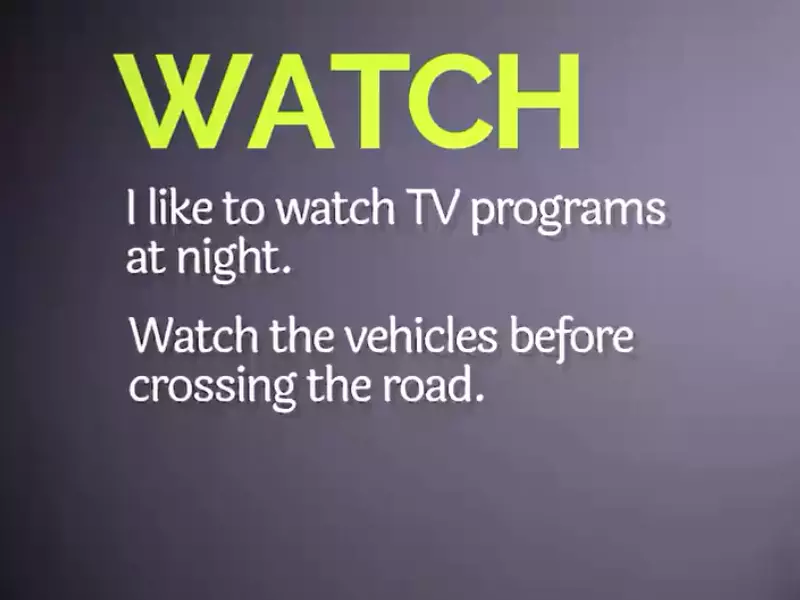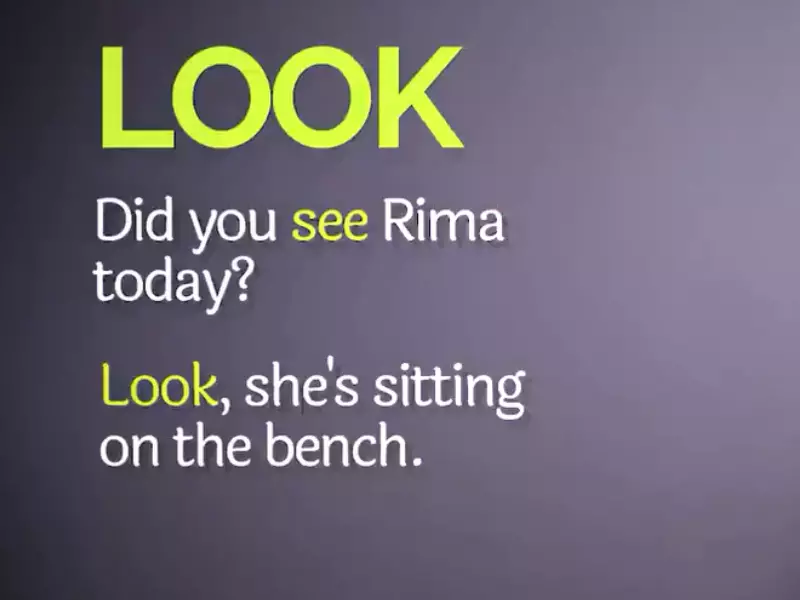The subtle distinctions in language not only enrich its texture but also sharpen our communication. Among such nuances, the difference between “watch” and “look” stands out, two verbs frequently used in daily conversation. Though they both relate to the act of seeing, their usage is nuanced by context and intention, reflecting the depth and precision of English.
At its core, “look” refers to the act of directing one’s gaze towards something for a brief moment, often without a specific focus or intention. In contrast, “watch” implies observing something attentively over a period, usually with a focus or purpose in mind. These differences highlight the verbs’ distinct nuances in terms of duration, attention, and intention.
Understanding when to use “watch” versus “look” goes beyond mere vocabulary knowledge—it’s about grasping the subtle cues that guide effective communication. This distinction is particularly evident in various contexts, from the arts and media to everyday interactions, where the right choice of word can convey the depth of engagement or the nature of one’s interest.

Core Meanings
Look
Basic Definition
The verb “look” refers to the act of directing one’s gaze towards something in order to see it. It is a voluntary action that involves focusing the eyes on a specific object or area, often for a short period. The essence of looking lies in the intention to see something more clearly or to gather information from one’s surroundings.
Contextual Usage
The usage of “look” varies significantly based on the context. Here are a few examples that highlight its versatile application:
- Observation: “Look at the sky to see the stars.”
- Searching: “Look in the drawer for the keys.”
- Attention: “Look at me when I’m talking to you.”
- Direction: “Look to the left before crossing.”
These examples illustrate how “look” can denote a range of actions from casual observation to active searching.
Watch
Basic Definition
“Watch” implies observing someone or something for a period, especially for a purpose or with interest. Unlike “look,” which can be brief and casual, to watch involves continuous attention over time. Watching is often associated with monitoring movements or maintaining focus on a dynamic scene or activity.
Contextual Usage
“Watch” finds its relevance in various contexts, underlining the aspect of duration and attention:
- Entertainment: “Watch a movie.”
- Surveillance: “Watch the suspect’s movements.”
- Care: “Watch the baby while I’m out.”
- Learning: “Watch how I do it and try to replicate.”
Each instance emphasizes the sustained nature of the act, whether for enjoyment, protection, or acquisition of knowledge.
Usage Scenarios
Quick Glances vs. Continuous Observation
Look for Brief Moments
“Look” is best suited for scenarios requiring quick glances or immediate visual confirmation:
- Checking the time
- Glancing at a notification
- Looking at signs for directions
These actions are short-lived and often instinctive, requiring minimal commitment.
Watch for Prolonged Periods
Conversely, “watch” implies engagement and continuity:
- Watching a TV series
- Observing wildlife in their natural habitat
- Monitoring security footage
Here, the emphasis is on the duration of observation, often with a specific focus or interest.
Intention and Focus
Intent Behind Look
The intent behind “look” is primarily to acquire information quickly or to direct attention momentarily. It’s about immediate comprehension or identification, without the necessity of prolonged focus.
Intent Behind Watch
In contrast, “watch” is driven by the desire for continued observation or engagement with the subject. Whether for entertainment, learning, or security, the underlying intention is to remain attentive over time.
Linguistic Contexts
Collocations
Common Phrases with Look
- Look before you leap.
- Look away
- Take a look
- Look up to someone
These phrases underscore the instantaneous or evaluative nature of looking.
Common Phrases with Watch
- Watch your step.
- Watch over someone.
- Binge-watch.
- Watch out for danger.
Here, the focus is on vigilance, care, or sustained engagement.
Verbal Commands
Instructions Involving Look
Commands involving “look” are often about directing immediate attention:
- “Look here!”
- “Look at this example.”
- “Look out the window.”
Such instructions usually aim to prompt a quick response or awareness.
Instructions Involving Watch
Instructions to “watch” tend to prepare one for longer-term observation or caution:
- “Watch how I do this.”
- “Watch the road while driving.”
- “Watch this documentary on history.”
The expectation is for the listener to commit their attention for an extended period or to be mindful of potential risks or lessons.

Visual Arts and Media
Photography and Painting
Photography and painting are two mediums where the distinction between look and watch becomes fascinating. When we look at a painting or a photograph, we engage in a momentary interaction. It’s about absorbing the visual details, understanding the artist’s intent, and appreciating the composition’s aesthetics. This act is static, allowing the viewer to explore the depths of a scene or the emotion captured in a still frame.
In contrast, watching film or video involves a dynamic engagement. Here, the viewer’s attention is not just on the visual elements but also on the narrative unfolding over time. Watching requires a commitment to follow the storyline, characters, and changes, making it a more prolonged and involved process.
News and Broadcasts
Using Look for Images
In the context of news and broadcasts, looking at images involves analyzing and interpreting a single moment in time. It could be a powerful photograph in a newspaper or a static image on a news website. The viewer looks to gain information, understand the context, or feel the emotional weight of the subject matter.
Using Watch for Live Events
Conversely, watching live events like news broadcasts or live streams demands continuous attention. Viewers watch to stay informed about unfolding events, requiring an ongoing engagement that evolves with the story.
Psychological Implications
Attention and Perception
The cognitive processes behind looking and watching are distinct yet interconnected. Looking is about directing our visual attention to specific points of interest, often guided by immediate goals or needs. This action is selective and purposeful. Watching, however, implies a sustained attention where the brain processes a series of visual inputs over time, integrating them into a coherent narrative or understanding.
Emotional Responses
The emotional impact of looking versus watching can vary greatly. When we look at something, the emotional response can be immediate and intense but often fleeting. In contrast, watching something allows for a build-up of emotions, evolving as the narrative or visual sequence progresses. This can lead to a more profound and lasting emotional impact.
Cultural Variations
Language and Dialects
The way look and watch are used can vary significantly across English dialects. Some dialects may use these verbs interchangeably in contexts where others see a clear distinction. Additionally, the influence of culture on language usage means that the same action might be described differently depending on geographical or cultural contexts.
Non-verbal Communication
In non-verbal communication, looking and watching carry distinct meanings. A direct look can convey confidence, interest, or challenge, while watching someone might be perceived as curiosity, surveillance, or even intrusion. Understanding these nuances is crucial in social interactions to avoid misinterpretations.
Practical Advice
Improving Communication Skills
To enhance communication skills, being aware of when to use look versus watch is key. Here are some tips:
- Use look when referring to a brief, intentional glance.
- Use watch when describing the act of observing something over a period.
Language Learning
For ESL learners, mastering the nuances between look and watch can be challenging but rewarding. Strategies include:
- Practice exercises focusing on contextual usage.
- Immersion in media to understand practical applications.
Frequently Asked Questions
What is the main difference between watch and look?
The main difference lies in the level of attention and duration. To “look” means to direct one’s gaze towards something briefly, often without a specific purpose. “Watch” implies a more prolonged focus, observing something attentively over time with intentional scrutiny.
When should I use watch instead of look?
Use “watch” when you’re referring to an activity that involves continuous observation or focus over a period. This is typical for scenarios like watching a movie, observing a sports game, or monitoring a situation, where your attention is sustained and engaged.
Can “look” and “watch” be used interchangeably?
While “look” and “watch” are both related to the act of seeing, they are not always interchangeable due to their nuanced differences in intention and duration. Choosing one over the other depends on the context and the specific nature of the visual engagement.
How do cultural variations affect the use of look and watch?
Cultural variations can influence the interpretation and usage of “look” and “watch.” Different languages and dialects may have unique verbs or expressions that capture similar distinctions, affecting how speakers of English as a second language perceive and use these verbs.
Conclusion
The distinction between “watch” and “look” exemplifies the precision and nuance of the English language. By understanding and applying these differences, we can communicate more accurately and effectively, enriching our expressions and interactions. This subtle linguistic awareness not only enhances our vocabulary but also deepens our engagement with the world around us.
In a world teeming with visual stimuli, mastering the use of “watch” and “look” equips us with the linguistic tools to describe our experiences with greater specificity and nuance. Whether we are engaged in a fleeting glance or a focused observation, the words we choose to describe these acts matter, reflecting the depth of our attention and the intent behind our gaze.
